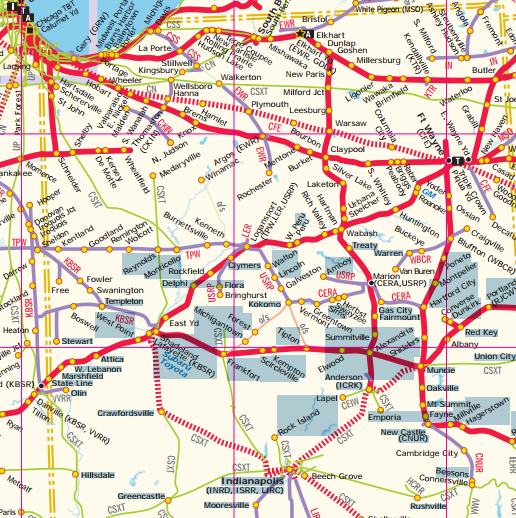When we stopped at a filling station because my morning coffee had been processed, I moved my camera up front were I could easily grab it. While taking photos of highway congestion, I noticed a container truck.
 |
| 20180822 4034 The "bar" near the right side is my van's radio antennae. |
I knew about JB Hunt and ONE, but I learned about the Hub Group on this trip because several of the containers on I-65 had their name and logo. "Hub Group’s drayage operation is stronger than ever. Known as Hub Group Trucking, we are one of the largest dray providers in the United States, and a leader in international and domestic intermodal drayage. How can we improve your everyday dray?" [metamorphosis] Looking at their web site, I have learned that I need to learn what "3PL" means. Hub Group has white papers on the history of intermodal and "The Metamorphosis of Drayage." The later paper confirms that a dray driver can spend most nights in his or her own bed. It also means that they can buy "day-cabs," which I'm sure are cheaper than sleeper-cabs. They have been doing electronic logging for a while so the new Federal laws requiring electronic logging are not disruptive for them. With 3000 tractors under their control, the are the eighth largest trucking firm.
Here is a shot of another one at a more readable angle.
I learned that taking photos of an object with an approach speed way over 100mph is a little tricky. I deleted all of the partial images except for this one. Even CSX avoids their own railroad for container traffic.
I noticed a container storage facility north of Indianapolis that had quite a few ONE containers. Looking at a satellite image later, I found Multi-Modal Trucking. Note that there are no railroad intermodal yards close to it.
I'm going to experiment with using the blog's video import rather than putting a really short video on YouTube. I took a video to capture how slow the traffic was going. This was on I-70.
There were trucks as far as the eye could see.
We didn't see much container traffic on I-70 except for another CSX drayage. It was parked on the side of the road, and we went past it way too fast for me to get a photo of it. But I did take a photo of the next millage marker to remind me of the CSX container and to record its location. Looking at a map, is it coming from North Baltimore to the Columbus area? If so, and if it is using Interstates, the route is rather circuitous.
 |
| INDOT plus Paint |
CSX has torn up Monon's direct route between Monticello and Indianapolis. The Big Four route along US-52 is now part of KB&S and that route between Lafayette and Indianapolis has been torn up. Amtrak uses different segments of different railroads to get from Union Station to Indianapolis. CSX routes its traffic to southern markets through Terre Haute and Evansville. But it does look like it still has a route using former Monon routes to Crawfordsville and then a former Pennsy route to Indianapolis.
 |
| NS System Map |
(Facebooked)
Ean Kahn-Treras CSX uses a big chunk of the old Monon between Maynard Jct in Munster, IN and Crawfordsville, IN. From there they have inherited a section of old Conrail track east/southeast to Indy. The ol’ Peoria and Eastern which was a NYC subsidiary I believe.
Ean Kahn-Treras Q642 and Q643 and the Barr Yd-Indy train and the counterpart. A couple other unit trains of grain/fertilizer/agricultural products run this way as well. Less that 10 movements a day for sure.
Dennis DeBrulerYou and 1 other manage the membership, moderators, settings, and posts for Chicago Railroad Historians. I'm glad to hear they run carload traffic between Chicago and Indy. I do know that CSX wanted to service a big intermodal yard near Crete, IL. But I think the Crete people looked at what happened to Elwood, IL and fought it. (And then along came Harrison Hunter who closed down the use of the cranes at North Baltimore and cancelled their participation in the Baltimore tunnel enlargement and probably made all container traffic construction mote.) I'm normally not sympathetic to NIMBY because I live in Downers Grove just a few blocks away from The Racetrack. But I have to admit that intermodal yards appear to be bad news for the local highways.






Re: that packages going less than 500 miles use trucks and packages going more than 500 miles use trains
ReplyDeleteThere's been a "truth known by all" for at least 50 years now that "trains can't make money carrying trucks/containers less than 500 miles". (I'm pretty sure this was the 11th commandment).
You'd think tho, looking at miles and miles of trucks, hour after hour, day after day, week after week, month after month, year after year, (in Carl Sagan terms billions and billions of trucks), you'd THINK - just some HOW - there'd be some WAY for the railroads to pick up some of this traffic.
But... I guess if it doesn't fit into the existing railroad traffic patterns it just isn't going to get done.
I've been wondering for years now... If the Erie Lackawanna across Indiana and Ohio were to magically re-appear, would the BNSF and UP still terminate all their trains in Chicago? I think they would. The EL would (again) slowly rust away (but, at least this time they turn it into a bike trail. We ARE make progress doing that anyway...)